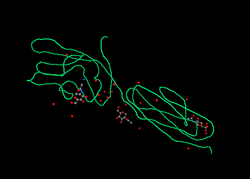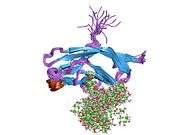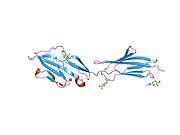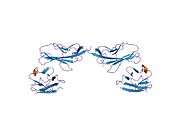CD2
CD2 (cluster of differentiation 2) is a cell adhesion molecule found on the surface of T cells and natural killer (NK) cells. It has also been called T-cell surface antigen T11/Leu-5, LFA-2,[5] LFA-3 receptor, erythrocyte receptor and rosette receptor.[6]
Function
It interacts with other adhesion molecules, such as lymphocyte function-associated antigen-3 (LFA-3/CD58) in humans, or CD48 in rodents, which are expressed on the surfaces of other cells.[7]
In addition to its adhesive properties, CD2 also acts as a co-stimulatory molecule on T and NK cells.[8]
Diagnostic relevance
CD2 is a specific marker for T cells and NK cells, and can therefore be used in immunohistochemistry to identify the presence of such cells in tissue sections. The great majority of T cell lymphomas and leukaemias also express CD2, making it possible to use the presence of the antigen to distinguish these conditions from B cell neoplasms.[9]
Classification
Due to its structural characteristics, CD2 is a member of the immunoglobulin superfamily; it possesses two immunoglobulin-like domains in its extracellular portion.[8]
Interactions
CD2 has been shown to interact with CD2BP2,[10] Lck[11] and PSTPIP1.[12]
References
- 1 2 3 GRCh38: Ensembl release 89: ENSG00000116824 - Ensembl, May 2017
- 1 2 3 GRCm38: Ensembl release 89: ENSMUSG00000027863 - Ensembl, May 2017
- ↑ "Human PubMed Reference:".
- ↑ "Mouse PubMed Reference:".
- ↑ Sanchez-Madrid F, Krensky AM, Ware CF, Robbins E, Strominger JL, Burakoff SJ, Springer TA (1982). "Three distinct antigens associated with human T-lymphocyte-mediated cytolysis: LFA-1, LFA-2, and LFA-3". Proc Natl Acad Sci U S A. 79 (23): 7489–93. doi:10.1073/pnas.79.23.7489. PMC 347365. PMID 6984191.
- ↑ Uniprot database entry for CD2 (accession number P06729)
- ↑ Wilkins AL, Yang W, Yang JJ (2003). "Structural biology of the cell adhesion protein CD2: from molecular recognition to protein folding and design". Curr Protein Pept Sci. 4 (5): 367–73. doi:10.2174/1389203033487063. PMID 14529530.
- 1 2 Yang JJ, Ye Y, Carroll A, Yang W, Lee HW (2001). "Structural biology of the cell adhesion protein CD2: alternatively folded states and structure-function relation". Curr Protein Pept Sci. 2 (1): 1–17. doi:10.2174/1389203013381251. PMID 12369898.
- ↑ Leong, Anthony S-Y; Cooper, Kumarason; Leong, F Joel W-M (2003). Manual of Diagnostic Cytology (2 ed.). Greenwich Medical Media, Ltd. p. 61. ISBN 1-84110-100-1.
- ↑ Nishizawa K, Freund C, Li J, Wagner G, Reinherz EL (December 1998). "Identification of a proline-binding motif regulating CD2-triggered T lymphocyte activation". Proc. Natl. Acad. Sci. U.S.A. 95 (25): 14897–902. doi:10.1073/pnas.95.25.14897. PMC 24547. PMID 9843987.
- ↑ Bell GM, Fargnoli J, Bolen JB, Kish L, Imboden JB (January 1996). "The SH3 domain of p56lck binds to proline-rich sequences in the cytoplasmic domain of CD2". Journal of Experimental Medicine. 183 (1): 169–78. doi:10.1084/jem.183.1.169. PMC 2192399. PMID 8551220.
- ↑ Li J, Nishizawa K, An W, Hussey RE, Lialios FE, Salgia R, Sunder-Plassmann R, Reinherz EL (December 1998). "A cdc15-like adaptor protein (CD2BP1) interacts with the CD2 cytoplasmic domain and regulates CD2-triggered adhesion". EMBO J. 17 (24): 7320–36. doi:10.1093/emboj/17.24.7320. PMC 1171078. PMID 9857189.
Further reading
- Sayre PH, Reinherz EL (1989). "Structure and function of the erythrocyte receptor CD2 on human T lymphocytes: a review". Scand. J. Rheumatol. Suppl. 76: 131–44. PMID 2471997.
- Rouleau M, Mollereau B, Bernard A, Metivier D, Rosenthal-Allieri MA, Charpentier B, Senik A (1997). "CD2 induced apoptosis of peripheral T cells". Transplant. Proc. 29 (5): 2377–8. doi:10.1016/S0041-1345(97)00410-7. PMID 9270771.
- Lüscher B (2001). "Function and regulation of the transcription factors of the Myc/Max/Mad network". Gene. 277 (1–2): 1–14. doi:10.1016/S0378-1119(01)00697-7. PMID 11602341.
- Yang JJ, Ye Y, Carroll A, Yang W, Lee HW (2002). "Structural biology of the cell adhesion protein CD2: alternatively folded states and structure-function relation". Curr. Protein Pept. Sci. 2 (1): 1–17. doi:10.2174/1389203013381251. PMID 12369898.
- Bell GM, Seaman WE, Niemi EC, Imboden JB (1992). "The OX-44 molecule couples to signaling pathways and is associated with CD2 on rat T lymphocytes and a natural killer cell line". J. Exp. Med. 175 (2): 527–36. doi:10.1084/jem.175.2.527. PMC 2119111. PMID 1346273.
- Marie-Cardine A, Maridonneau-Parini I, Ferrer M, Danielian S, Rothhut B, Fagard R, Dautry-Varsat A, Fischer S (1992). "The lymphocyte-specific tyrosine protein kinase p56lck is endocytosed in Jurkat cells stimulated via CD2". J. Immunol. 148 (12): 3879–84. PMID 1351089.
- Hahn WC, Menu E, Bothwell AL, Sims PJ, Bierer BE (1992). "Overlapping but nonidentical binding sites on CD2 for CD58 and a second ligand CD59". Science. 256 (5065): 1805–7. doi:10.1126/science.1377404. PMID 1377404.
- Luzzati AL, Giacomini E, Giordani L, Pugliese O, Viora M, Chersi A (1992). "The antigen-specific induction of normal human lymphocytes in vitro is down-regulated by a conserved HIV p24 epitope". Immunol. Lett. 33 (3): 307–14. doi:10.1016/0165-2478(92)90078-3. PMID 1385321.
- Ruegg CL, Strand M (1991). "A synthetic peptide with sequence identity to the transmembrane protein GP41 of HIV-1 inhibits distinct lymphocyte activation pathways dependent on protein kinase C and intracellular calcium influx". Cell. Immunol. 137 (1): 1–13. doi:10.1016/0008-8749(91)90051-C. PMID 1832084.
- Schraven B, Samstag Y, Altevogt P, Meuer SC (1990). "Association of CD2 and CD45 on human T lymphocytes". Nature. 345 (6270): 71–4. doi:10.1038/345071a0. PMID 1970422.
- Samelson LE, Fletcher MC, Ledbetter JA, June CH (1990). "Activation of tyrosine phosphorylation in human T cells via the CD2 pathway. Regulation by the CD45 tyrosine phosphatase". J. Immunol. 145 (8): 2448–54. PMID 1976695.
- Luzzati AL, Pugliese O, Giacomini E, Giordani L, Quintieri F, Hraba T, Mach O, Krchnák V, Vágner J (1990). "Immunoregulatory effect of a synthetic peptide corresponding to a region of protein p24 of HIV". Folia Biol. (Praha). 36 (1): 71–7. PMID 2111780.
- Seed B, Aruffo A (1987). "Molecular cloning of the CD2 antigen, the T-cell erythrocyte receptor, by a rapid immunoselection procedure". Proc. Natl. Acad. Sci. U.S.A. 84 (10): 3365–9. doi:10.1073/pnas.84.10.3365. PMC 304871. PMID 2437578.
- Peterson A, Seed B (1987). "Monoclonal antibody and ligand binding sites of the T cell erythrocyte receptor (CD2)". Nature. 329 (6142): 842–6. doi:10.1038/329842a0. PMID 2444890.
- Sayre PH, Chang HC, Hussey RE, Brown NR, Richardson NE, Spagnoli G, Clayton LK, Reinherz EL (1987). "Molecular cloning and expression of T11 cDNAs reveal a receptor-like structure on human T lymphocytes". Proc. Natl. Acad. Sci. U.S.A. 84 (9): 2941–5. doi:10.1073/pnas.84.9.2941. PMC 304776. PMID 2883656.
- Diamond DJ, Clayton LK, Sayre PH, Reinherz EL (1988). "Exon-intron organization and sequence comparison of human and murine T11 (CD2) genes". Proc. Natl. Acad. Sci. U.S.A. 85 (5): 1615–9. doi:10.1073/pnas.85.5.1615. PMC 279824. PMID 2894031.
- Lang G, Wotton D, Owen MJ, Sewell WA, Brown MH, Mason DY, Crumpton MJ, Kioussis D (1988). "The structure of the human CD2 gene and its expression in transgenic mice". EMBO J. 7 (6): 1675–82. PMC 457152. PMID 2901953.
- Leca G, Boumsell L, Fabbi M, Reinherz EL, Kanellopoulos JM (1986). "The sheep erythrocyte receptor and both alpha and beta chains of the human T-lymphocyte antigen receptor bind the mitogenic lectin (phytohaemagglutinin) from Phaseolus vulgaris". Scand. J. Immunol. 23 (5): 535–44. doi:10.1111/j.1365-3083.1986.tb01985.x. PMID 3085210.
- Sewell WA, Brown MH, Dunne J, Owen MJ, Crumpton MJ (1986). "Molecular cloning of the human T-lymphocyte surface CD2 (T11) antigen". Proc. Natl. Acad. Sci. U.S.A. 83 (22): 8718–22. doi:10.1073/pnas.83.22.8718. PMC 387002. PMID 3490670.
External links
- CD2+Antigen at the US National Library of Medicine Medical Subject Headings (MeSH)
- Mouse CD Antigen Chart
- Human CD Antigen Chart
- Human CD2 genome location and CD2 gene details page in the UCSC Genome Browser.









